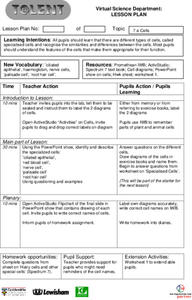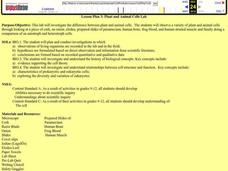Curated OER
What's Outside the Cell Membrane ?
Students examine the cell coats (matrix) of chondrocytes and fibroblasts and observe these cells actively exclude particles which are released around them. They observe the function of the cell membrane as a gatekeeper as it prevents...
Curated OER
How HIV Infects Cells
In this how HIV infects cells worksheet, students read the given information about how HIV infects cells. Students explain the role of various structures in HIV infection. Students design a drug that might slow the rate of cellular...
Curated OER
Blood and the Circulatory System
For this circulatory system worksheet, students review the organs that are involved with this body system, including their structure and function. Students explore the problems that can occur with the circulatory system. This worksheet...
Curated OER
Microviewer
In this microviewer activity, students observe several types of cells. Students draw each type of cell and label the important parts. Students also answer questions relatable to the cell and the purpose for study.
Curated OER
P.L.E.P: Parts of Blood
Students examine the different parts of blood. In this human blood lesson students work in groups and identify parts of blood and construct a model of human blood.
Curated OER
Born of Blood: Inheritance of Blood Types
Learners examine inheritance of blood types. In the chromosome lesson plan, students create a model of chromosome and predict the blood type of offspring.
Nuffield Foundation
A Closer Look at Blood
Here is a lab that has teenage scientists examining samples of their own blood under a microscope. Learners carefully prepare slides, then make detailed observations and identifying different types of cells using a key.
Curated OER
World Blood Donor Day
In this World Blood Donor Day worksheet, students complete activities such as reading a passage, phrase matching, fill in the blanks, correct words, multiple choice, spelling, sequencing, scrambled sentences, writing questions, survey,...
Curated OER
Explore Rx Quiz
In this exploring prescriptions activity, students answer 6 multiple choice questions related to diseases, medicine, the human body and poisonous plants. Students use an on line web site that gives them an immediate score.
Curated OER
The Battle of the Guts
Students listen to story, The Magic School Bus: Inside Ralphie, take notes from story on how body fights germs, identify different functions of immune system, and use Kid Pix slide show to explain how body fights viruses and bacteria.
Curated OER
Nerve Cell Informercials
Students research the structure and function of the nervous system. They prepare a model or representation of neural transmission. Students create an infomercial about nerve cells.
Curated OER
Quiz Questions - Cells
In this cells worksheet, students read and choose the multiple choice answers to 20 questions involving cells, microscopes, and the life process of Growth.
Curated OER
Cells
Pupils explore the types of cells and their appropriate function. After observing a PowerPoint presentation, students draw diagrams of cells. Using a specified website, pupils identify parts of plant and animal cells. They answer...
Curated OER
Making Blood
Fifth graders review what they have already gathered about human blood. After reviewing the components of blood, they work together to make their own. Using the internet, they complete a blood web hunt and share their discoveries with...
LABScI
Circulation and Respiration: Vital Signs
What do your vital signs tell your doctor? An engaging hands-on lesson has your learners monitor their own lung capacity, blood pressure, and heart rate. They then connect the vital measures to the workings of the circulatory and...
Curated OER
Plant and Animal Cells
High schoolers investigate the difference between plant and animal cells. They observe a variety o plant and animals cells by looking at a piece of cork, an onion, elodea, prepared slides of paramecium, human bone, frog blood, and human...
DiscoverE
Heart Valve Replacement
Put your heart into it. Scholars design and build replacements for mitral heart valves. Obviously, they can't test their creations on a real heart, so a box with marbles (to represent blood cells) will suffice.
Curated OER
Osmosis
For this biology worksheet, students determine how many solvent and solute molecules there are in the red blood cell and the IV fluid. Then they determine whether the IV fluid is hypertonic, hypotonic, or isotonic to the red blood cell.
Curated OER
How to Make an Artificial Organ
Students design bionic organs or limbs. In this medical technology lesson, students view a video about artificial organs and prosthetic limbs. They research the medical technology behind these advances and work to design a organ or limb...
Curated OER
The Circulatory System
In this circulatory system worksheet, students review the functions of red blood cells, white blood cells, and platelets. Students label the parts of a human heart on a diagram. This worksheet has 4 short answer, 13 matching, and 9 true...
Towson University
Mystery Disease
How did scientists determine the cause of illness before technology? Science scholars play the role of medical researcher in an engaging guided inquiry activity. Using observations, technical reading, and Punnett squares, learners...
Curated OER
Blood: Transport and Protection
In this blood instructional activity, students review what makes up blood: plasma, platelets, and red and white blood cells. Students also learn how the blood helps fight viruses, bacteria, and other foreign substances. This...
Curated OER
The Cardiac 100
Students make a full scale diagram. In this heart and blood flow lesson, students pretend they must design the cardiac 100 racecourse and they must teach the new blood cells how to get around the heart. Students create a mini drawing and...
Curated OER
Inside the Cell
In this science worksheet, students study the structure and function of the cell by reading the information, studying the pictures and diagrams and finally completing a challenging crossword puzzle. There are 84 pages available.

























